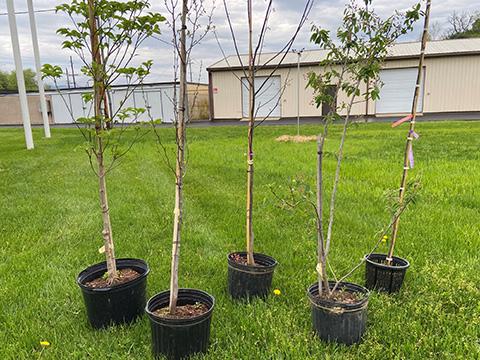The grounds around Building 1071 on the NCI at Frederick campus are about to receive a new ecological improvement network.
It won’t come with complex equipment, nor will it add to the campus’ ubiquitous metallic sheen of steam pipes or modules encasing crucial apparatus. Instead, passersby will only see five saplings—because they’re the network.
In a move to improve water quality and manage runoff, the Environment, Health, and Safety Directorate is hosting an event to plant the saplings around the building on May 12 from noon to 1 p.m. Any employee or contractor is welcome to help and can email FNLGreenTeam@nih.gov to sign up.
Trees are among the most cost-effective ecological improvement and water management systems available. Their canopies catch and slow rainfall, staggering the amount that reaches the ground. This increases absorption into the soil by allowing the rain to soak in gradually over a longer period. It also decreases flash flooding, which means less erosion and less runoff that washes unwanted chemicals and nutrients into waterways.
Trees double as living water filters. Their roots allow them to take up and store nutrients and chemicals, including those found in runoff, like nitrogen and phosphorous.
The result is better water quality in nearby waterways and the municipal systems that draw from them. A 2019 analysis in Malawi even found that a 14% increase in deforestation harmed access to clean drinking water as much as an estimated 9% decrease in rainfall would.
“The more trees in a watershed, the lower the drinking water treatment costs—an ecosystem service, provided to us at no cost,” said Kylee Stenersen, an EHS officer involved with the event.
The five saplings soon to be planted—a flowering dogwood, a hornbeam, an eastern redbud, and two serviceberry trees—will help to that end. All will have wide, sprawling canopies once they’ve grown. On NCI at Frederick’s campus, with its gently rolling terrain and paved surfaces that exacerbate runoff, their role as water filters will be put to good use.
They’ll have other ecological benefits too. Their vibrant spring blooms are known for attracting pollinators, and their leaves are a food source for native insects.
EHS’ event, a delayed celebration of Arbor Day, coincides with the re-formation of the Green Team, which is resuming activities as more employees return to working on-site. The team aims to promote environmental stewardship and accessible sustainability in ways that get employees involved.
The first Green Team meeting will be held from noon to 1 p.m. on June 14 in room 156 of Building 426. Attendance is open to all employees and contractors. A Webex option will be available for those who can’t attend in person.
EHS welcomes participants to bring their own ideas for future efforts, Stenersen said.
Questions about the tree planting or the Green Team can be directed to FNLGreenTeam@nih.gov. Remote-work and telework employees can access the June 14 Green Team meeting online.
Samuel Lopez is a technical editor in Scientific Publications, Graphics & Media (SPGM), where he writes for NCI at Frederick and Frederick National Laboratory’s news outlets; manages the day-to-day operations of the Poster newsletter; informally serves as an institutional historian; and edits scientific manuscripts, corporate documentation, and a slew of other written media. SPGM is the facilities’ creative services department and hub for editing, illustration, graphic design, formatting, and multimedia training and support.


